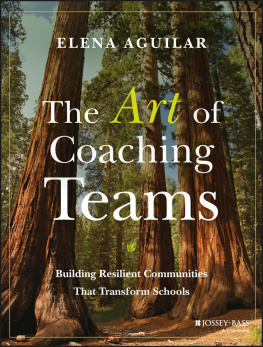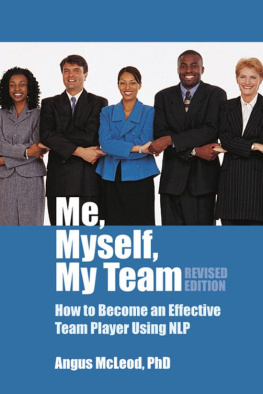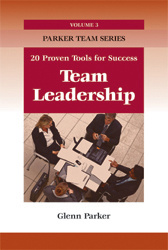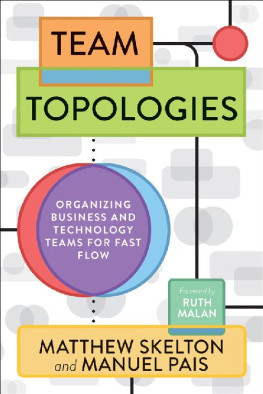Praise for Mining Group Gold
I have been a student of Mining Group Gold for more than twenty years, since first being exposed to it during my career at Xerox. Subsequently, in two senior leadership roles at MBM Corporation and at CARQUEST, I have personally used Toms processes to run my own meetings and have taught it to others and the feedback was always the same. Mining Group Gold increases productivity and the quality of work performed, as well as the satisfaction of participants. While I have acquired a significant number of business books over the years, only a handful remain close by to reference. Mining Group Gold is one of the few.
Edward V. Whirty, President, Coral Ridge Consulting
Mining Group Gold works! Using MGG concepts in my coaching work with corporate executive clients and entrepreneurial business owners has been a key factor in their ability to align their teams, accomplish desired outcomes, and deliver millions of dollars in improved bottom-line performance.
Rod Buchen, CEO, The Buchen Group
M INING G ROUP G OLD
M INING G ROUP G OLD
H OW TO C ASH I N ON
THE C OLLABORATIVE
B RAINPOWER OF A T EAM FOR
I NNOVATION AND R ESULTS
T HIRD E DITION
T HOMAS A. K AYSER
Copyright 1990, 1995, 2011 by Thomas A. Kayser. All rights reserved. Except as permitted under the United States Copyright Act of 1976, no part of this publication may be reproduced or distributed in any form or by any means, or stored in a database or retrieval system, without the prior written permission of the publisher.
ISBN 978-0-07-174119-4
MHID 0-07-174119-4
The material in this eBook also appears in the print version of this title: 978-0-07-174062-3, MHID 0-07-174062-7.
All trademarks are trademarks of their respective owners. Rather than put a trademark symbol after every occurrence of a trademarked name, we use names in an editorial fashion only, and to the benefit of the trademark owner, with no intention of infringement of the trademark. Where such designations appear in this book, they have been printed with initial caps.
McGraw-Hill eBooks are available at special quantity discounts to use as premiums and sales promotions, or for use in corporate training programs. To contact a representative please e-mail us at bulksales@mcgraw-hill.com.
This publication is designed to provide accurate and authoritative information in regard to the subject matter covered. It is sold with the understanding that the publisher is not engaged in rendering legal, accounting, or other professional service. If legal advice or other expert assistance is required, the services of a competent professional person should be sought.
From a Declaration of Principles Jointly Adopted by a Committee of the American Bar Association and a Committee of Publishers and Associations
TERMS OF USE
This is a copyrighted work and The McGraw-Hill Companies, Inc. (McGraw-Hill) and its licensors reserve all rights in and to the work. Use of this work is subject to these terms. Except as permitted under the Copyright Act of 1976 and the right to store and retrieve one copy of the work, you may not decompile, disassemble, reverse engineer, reproduce, modify, create derivative works based upon, transmit, distribute, disseminate, sell, publish or sublicense the work or any part of it without McGraw-Hills prior consent. You may use the work for your own noncommercial and personal use; any other use of the work is strictly prohibited. Your right to use the work may be terminated if you fail to comply with these terms.
THE WORK IS PROVIDED AS IS. McGRAW-HILL AND ITS LICENSORS MAKE NO GUARANTEES OR WARRANTIES AS TO THE ACCURACY, ADEQUACY OR COMPLETENESS OF OR RESULTS TO BE OBTAINED FROM USING THE WORK, INCLUDING ANY INFORMATION THAT CAN BE ACCESSED THROUGH THE WORK VIA HYPERLINK OR OTHERWISE, AND EXPRESSLY DISCLAIM ANY WARRANTY, EXPRESS OR IMPLIED, INCLUDING BUT NOT LIMITED TO IMPLIED WARRANTIES OF MERCHANTABILITY OR FITNESS FOR A PARTICULAR PURPOSE. McGraw-Hill and its licensors do not warrant or guarantee that the functions contained in the work will meet your requirements or that its operation will be uninterrupted or error free. Neither McGraw-Hill nor its licensors shall be liable to you or anyone else for any inaccuracy, error or omission, regardless of cause, in the work or for any damages resulting there from. McGraw-Hill has no responsibility for the content of any information accessed through the work. Under no circumstances shall McGraw-Hill and/or its licensors be liable for any indirect, incidental, special, punitive, consequential or similar damages that result from the use of or inability to use the work, even if any of them has been advised of the possibility of such damages. This limitation of liability shall apply to any claim or cause whatsoever whether such claim or cause arises in contract, tort or otherwise.
CONTENTS
F OREWORD
If you want to go fast, go alone. If you want to go far, go together.
Warren Buffett, Chairman, Berkshire Hathaway
I read this quote long after meeting Tom Kayser, yet the words in many ways typify how I remember him when we worked together at Xerox Corporation. I first met Tom over 25 years ago. I was just out of graduate school and joined Xerox as an analyst in Human Resources. Tom was leading a small team of Organization Effectiveness specialists. Working with Tom gave me a front row seat to effective organization change in progress. At the time, Xerox was embarking on a journey we called Leadership Through Quality. There were many aspects to this performance and culture changing initiative. None were more impactful and pervasive than driving better decision-making through disciplined processes and teamwork.
Today, process discipline and collaboration are well studied, practiced, and written about. But back in the early 1980s, these ideas were considered innovative and relatively untested across large enterprises. Champions of innovation are often big personalities and the sheer force of their conviction can produce the momentum needed for adoption of new ideas. That was not Tom. Toms approach was understated yet always confident that if managers utilized just a few simple collaboration tools with their teams, then they could extract, that is, mine gold within the group.
And who wouldnt want to get the very best out of their team--individually and collectively? Work is challenging, issues are complex, and answers are not obvious. Imagine having a very difficult problem to solve (that should be easy to do!) and you have been identified as the leader of a newly formed task force. There are opposing views, emotions are running high, there are power struggles and, yet, the required knowledge and experience to solve the issue reside among the very same people. How do you maximize all that human capital?
Over the years I have participated in numerous exercises that demonstrate time and again the collective power of the group. One exercise consisted of administering a set of questions to individual participants, who were then placed in teams. The teams then competed with one another to win by submitting the most correct responses that represented the collective agreement of the group. In debriefing the exercise the team discovered that, while their group answered many of the questions correctly, all of the right answers were actually known by at least one of the individuals on their team. All the knowledge they needed to win was right there, and yet the group was not effective at drawing out the contributions of each team member. And that was the Aha! momentthe realization that having individuals with all the knowledge, skills, and capabilities necessary for our business, school, or not-for-profit agency is not enough unless we can unleash both individual and collective capabilities.












